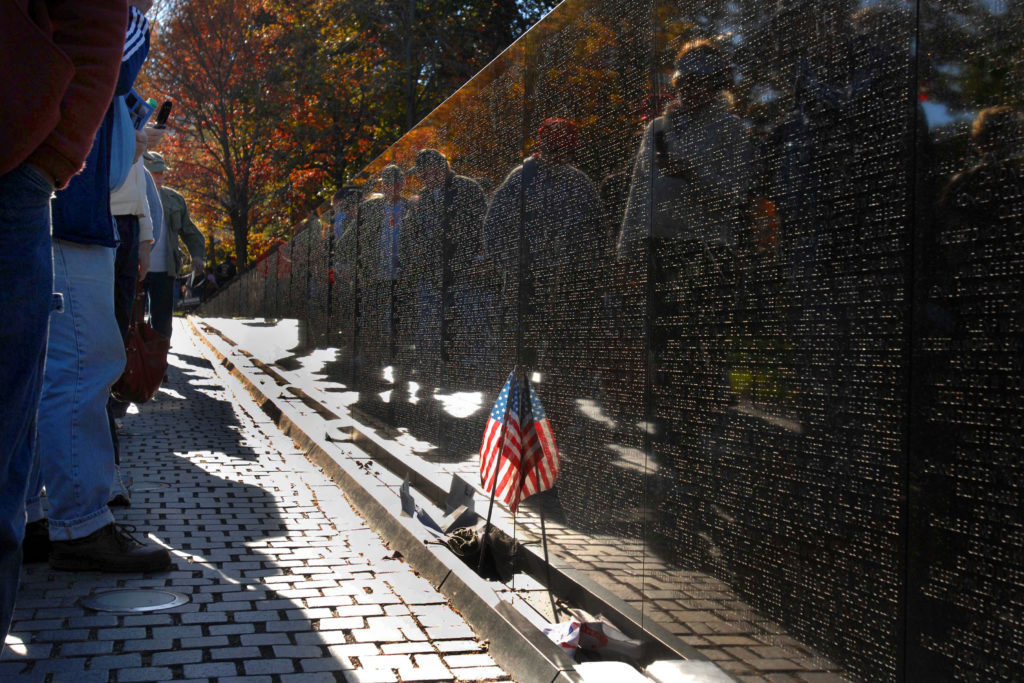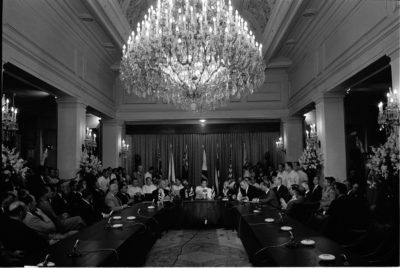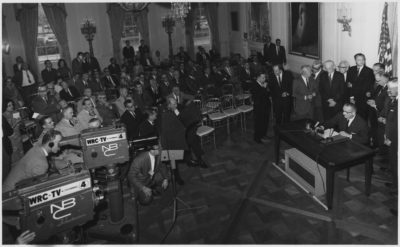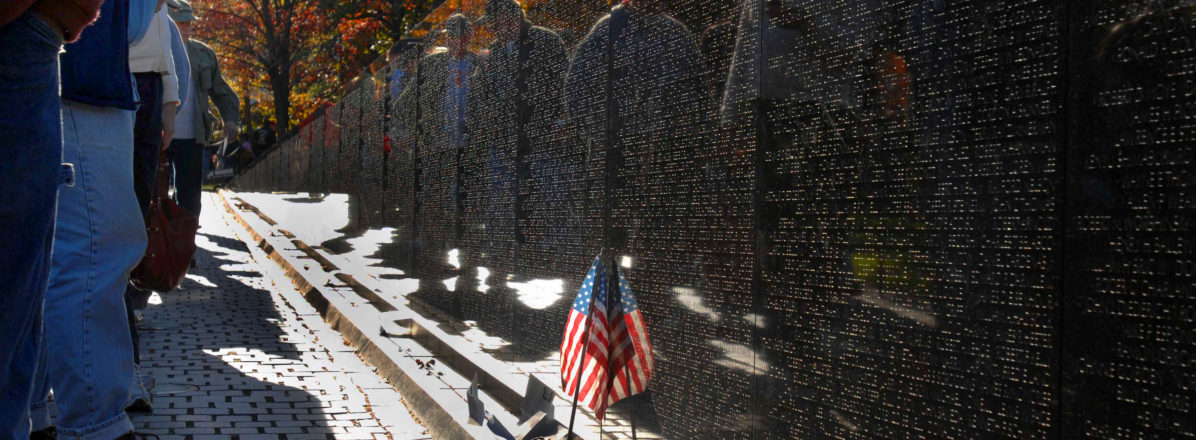A nation must think before it acts.

This essay is based on a presentation at the Butcher History Institute for Teachers on Why Does America Go To War?, March 25-26, 2017, sponsored by the Foreign Policy Research Institute, the First Division Museum at Cantigny, and Carthage College.
Why did the U.S. go to war in Vietnam? This is a question historians continue to debate. One of the main reasons it remains a source of argument is that it is difficult to say when the U.S. war actually began. Should we trace it back to the 1940s when President Harry Truman authorized U.S. financial support of the French war in Indochina? Did it begin in the 1950s when the Geneva Accords divided Vietnam in two and President Dwight Eisenhower offered U.S. aid to help establish a non-communist nation in the southern half to counter the communist north? Eisenhower’s “domino theory,” the idea that if one country in Southeast Asia fell to the communists, the entire region would fall, and the ripple effects would be felt throughout the Asia-Pacific world, informed not only his thinking about U.S. relations with the region but the policymaking of his successors, John F. Kennedy and Lyndon B. Johnson. Kennedy asserted that Americans would “pay any price, bear any burden” to support democratic nation building as a way to counter communist advances in Asia. During Johnson’s presidency, the U.S. escalated its war in Vietnam, starting with the Gulf of Tonkin Resolution in which Congress authorized Johnson to use military force without declaring war. In March 1965, U.S. Marines landed at Danang.
Rather than identifying one starting point, it is more accurate to understand U.S. intervention in Vietnam as a gradual process. It involved economic aid, political and military advisors, and boots on the ground. All of the key moments in the process emerged from different contexts and the thinking of various players, but there were three threads that unified them: communism, the Cold War, and credibility. Understanding the role of communism requires placing Vietnam in a regional context and examining Southeast Asian concerns about communism. A regional approach to the Vietnam War is important because U.S.-Vietnam relations and the Vietnam War did not occur in a vacuum. The global context is also important because Cold War tensions between the U.S., the Soviet Union, and China also shaped events related to the Vietnam War. At the same time that we must investigate Vietnamese and Southeast Asian agency regarding the conflict, we also must acknowledge the significance of Cold War superpower rivalries and decision making to how the war played out. Concerns about credibility motivated U.S. policymakers to commit advisors, money, materiel, and troops to Vietnam, lest allies lose faith in American resolve to build a global democratic bulwark against communism and adversaries hear threats ring hollow.
The context of decolonization helps explain regional Southeast Asian perspectives on communism. As local activists and political leaders established newly independent countries out of Europe’s former colonial empires, the U.S., the Soviet Union, and China saw these new nations as potential allies and hoped to draw as many as possible into their respective orbits. It mattered whether the new countries established communist or non-communist governments. Vietnam’s history offers a case study of decolonization in action. A colony of France since the mid-nineteenth century, Vietnam fell under Japanese control in 1940 after France surrendered to Germany during World War II. In September 1945, Ho Chi Minh, a nationalist who was also an internationally connected communist who helped establish the French Communist Party and spent time in China and Russia in the 1920s, declared the country’s independence in the wake of Japan’s defeat and the war’s end. France soon sought to reclaim its former colony and went to war with Ho and the Viet Minh, Vietnam’s independence movement. After the Viet Minh won a decisive victory at Dien Bien Phu in May 1954, France surrendered, and the Geneva Accords that summer called for dividing Vietnam in half at the seventeenth parallel.
Other Southeast Asian nations also transitioned from colonial to independent status in the years after World War II, and tensions and conflicts between communist and non-communist movements existed not just in Vietnam but also in Malaysia, Indonesia, and the Philippines. Regional non-communist governments supported the Republic of Vietnam, the southern half of the divided country, believing its existence was a crucial bulwark against the spread of communism in Southeast Asia. In 1954, Chiang Kai-shek of Taiwan and South Korea’s Syngman Rhee founded the Asian People’s Anticommunist League (APACL) as part of their efforts to resist communist insurgencies. Beginning in 1964, the central subject of the organization’s annual meetings was South Vietnam and how members of the APACL could offer political and military assistance. At the 1964 annual meeting in Taipei, delegates decided to open a special APACL office in Saigon to demonstrate support for the Saigon government. Newspapers in Bangkok, Kuala Lumpur, and Manila published editorials supporting South Vietnam. An APACL youth conference featured attendees from the U.S., including Tom Charles Huston and David Keene representing Young Americans for Freedom.[1]

President Marcos of the Philippines presiding over a SEATO meeting in 1966
Southeast Asia was so important in the minds of America policymakers and their allies that the U.S., along with Britain, France, Australia, New Zealand, Pakistan, the Philippines, and Thailand, established the Southeast Asia Treaty Organization (SEATO) in September 1954. SEATO’s purpose was to prevent communism from gaining ground in the region, and although South Vietnam, Cambodia, and Laos couldn’t join because the Geneva Accords prevented them from joining international military alliances, they were included as SEATO protectorates. This designation provided a justification for U.S. involvement in Vietnam because SEATO members pledged to act to prevent the spread of communism in Southeast Asia.[2]
Just as regional concerns about communism influenced support for South Vietnam, the Vietnam conflict also played into Cold War superpower rivalries, which, in turn, shaped superpower decision making. As the U.S., the Soviet Union, and China vied for alliances with newly independent countries, Vietnam became one of the proving grounds on which all three countries tried to make their mark. The U.S. gave economic and military aid to South Vietnam, while the Soviet Union and China offered similar assistance to North Vietnam. Hanoi leaders understood that they walked a tightrope between their two contentious benefactors, as North Vietnam received significant support from both countries. North Vietnam also benefitted from trade with Eastern Europe through its inclusion in the Soviet sphere. Although authorities in both Vietnams tried to assert themselves and resist superpower control, the Cold War power struggle between the U.S., the Soviet Union, and China was key in shaping the Vietnam War.[3]
In the context of the Cold War power struggle, and in the context of U.S. efforts to court allies in the decolonizing world, Americans had to prove that their pronouncements about containing communism, supporting non-communist governments, and aiding democracy building were credible. Presidents from Truman through Johnson worried about American credibility. During the Truman administration, the State Department issued NSC-68, a paper arguing that the Soviet Union was “animated by a new fanatic faith” and determined “to impose its absolute authority over the rest of the world.”[4] To combat the Soviet threat, the U.S. must embark on a massive buildup of conventional and nuclear weapons, NSC-68 contended. President Eisenhower had considered authorizing a U.S. military action, including a possible nuclear strike, to help the French at Dien Bien Phu in May 1954, but Congress refused to approve the use of military force unless it was part of an international coalition. Secretary of State John Foster Dulles failed to convince any major U.S. ally to help. After the Geneva Accords created South Vietnam, Eisenhower offered U.S. support to the new government of Ngo Dinh Diem. Eisenhower considered the partition of Vietnam a victory for the U.S. in the context of the Cold War. Like Korea, Vietnam was now only half communist, and the division of the country maintained the balance of power between the two spheres.[5]
President Kennedy’s concern about American credibility dated back to his time as a Congressman from Massachusetts. Kennedy argued that if the U.S. did not act aggressively to protect free nations, especially in Asia, China would come in and dominate the region. Yet, he believed the old ways of European imperialism like France’s attempt to recolonize Vietnam were wrong. That type of approach would just play into the hands of the communists, and in any case, Kennedy believed that the U.S. had an obligation to help build and support strong non-communist native governments. His model was the Philippines, where Colonel Edward Lansdale had groomed Ramon Magsaysay to be president. In 1956, Kennedy announced: “Vietnam represents the cornerstone of the Free World in Southeast Asia.”[6] This ideology informed his foreign policy worldview as president, beginning with his inaugural address, in which he declared: “Let every nation know, whether it wishes us well or ill, that we shall pay any price, bear any burden, meet any hardship, support any friend, oppose any foe, in order to assure the survival and the success of liberty.”[7]
Kennedy employed the rhetoric of idealism to try to convince the American public that the U.S. had a moral responsibility to help governments and political movements that were trying to resist communist insurgencies. Historians still debate what Kennedy would have done regarding Vietnam had he lived beyond November 1963. While publicly he seemed staunchly committed to containing communism in Asia, he expressed doubt privately about South Vietnam’s chances for survival and whether it was worth a U.S. investment. Some close to Kennedy and members of his administration believe he would have escalated as Johnson did. Others have maintained that he would not have escalated. Rhetoric scholars who have studied Kennedy’s speeches have argued that what Kennedy actually thought about Vietnam was almost irrelevant because his ideological public language would have made it very difficult for him to make a policy reversal on Vietnam.[8]

President Lyndon B. Johnson signs “Gulf of Tonkin” Resolution
When Johnson took the oath of office in the wake of Kennedy’s shocking death, he brought his own concerns about American credibility. Johnson ascribed to the domino theory, and he believed that South Vietnam was the victim of communist aggression from and directed by North Vietnam. If the U.S. failed to step in and help South Vietnam, it would send a message to the rest of Southeast Asia and the world that the U.S. was not truly committed to containing communism. The problem for Johnson was that deep down he didn’t necessarily want to commit U.S. troops to the fight. He believed the South Vietnamese should fight for themselves with American aid and advice. Publicly, though, he and members of his administration, especially Secretary of Defense Robert McNamara, emphasized the strategic importance of South Vietnam. McNamara pointed to Southeast Asia’s central location between India and Australia, New Zealand, and the Philippines as evidence of the region’s significance. A Hanoi victory in the war, McNamara argued, would place Vietnam that much closer to Chinese control, and then all of Southeast Asia would be in danger. “To defend Southeast Asia,” McNamara argued, “we must meet the challenge in South Vietnam.” The region mattered to the U.S. because “(i)n communist hands, this area would pose a most serious threat to the security of the United States and to the family of free-world nations.” Vietnam was America’s test case to prove that it could meet the global challenge of communist wars of liberation.[9]
Johnson’s anxieties about U.S. credibility, combined with political instability in Saigon, China’s resistance to negotiations, and Hanoi’s refusal to remove troops from South Vietnam and stop aiding the National Liberation Front led him to escalate the U.S. military presence in Vietnam from 1964 through 1967. The election of Nguyen Van Thieu to South Vietnam’s presidency in 1967 brought hope for stability, but 1968 opened with the Tet Offensive, which turned Americans against the war and influenced Johnson’s decision to not seek reelection. His successor, Richard Nixon, entered the presidency in a world that looked much different than it had in 1964. Americans across the political spectrum opposed the Vietnam War, the U.S. and the Soviet Union entered a period of détente, and Nixon’s visit to China opened a new era in Sino-American relations. The changing conditions of the context surrounding Vietnam made what happened there seem less strategically important to the U.S. than it had appeared in 1954 or 1965. Additionally, Nixon was more pragmatic than idealistic in his foreign policy worldview. He believed that the U.S. should cast aside ideological differences in order to build alliances—as long as they were in America’s best interests.
America’s decision to go to war in Vietnam did not involve a Pearl Harbor or Franz Ferdinand moment. U.S. intervention was a gradual process that included economic aid, diplomacy, politics, presidential personalities, and military force. Regional alliances in Southeast Asia and superpower tensions between the U.S., China, and the Soviet Union set the international context for the war. American policymakers’ desires to prove that the U.S. was actually committed to stopping the spread of communism formed the ideological foundation of America’s approach to Vietnam over the course of four presidencies. Historians may never agree about when the war actually started, but all of these factors informed U.S. policymakers’ decisions to intervene.
Suggested Additional Readings
Asselin, Pierre. Hanoi’s Road to the Vietnam War, 1954-1965. Berkeley, CA: University of California Press, 2015.
Chapman, Jessica. Cauldron of Resistance: Ngo Dinh Diem, the United States, and 1950s Southern Vietnam. Ithaca, NY: Cornell University Press, 2013.
Goscha, Christopher. Vietnam: A New History. New York: Basic Books, 2016.
Herring, George. America’s Longest War: The United States and Vietnam, 1965-1975. New York: McGraw-Hill, 2001.
Lawrence, Mark Atwood. Assuming the Burden: Europe and the American Commitment to War in Vietnam. Berkeley, CA: University of California Press, 2007.
Lind, Michael. Vietnam, The Necessary War: A Reinterpretation of America’s Most Disastrous Military Conflict. New York: Free Press, 2002.
Logevall, Fredrik. Choosing War: The Lost Chance for Peace and the Escalation of War in Vietnam. Berkeley, CA: University of California Press, 2001.
Miller, Edward. Misalliance: Ngo Dinh Diem, the United States, and the Fate of South Vietnam. Cambridge, MA: Harvard University Press, 2013.
Nguyen, Lien-Hang T. Hanoi’s War: An International History of the War for Peace in Vietnam. Chapel Hill, NC: University of North Carolina Press, 2013.
Wiest, Andrew. Triumph Revisited: Historians Battle for the Vietnam War. London: Routledge, 2010.
[1] Tu Hoang Nam Hung, Hoi Khong Hoc Viet Nam, Kinh goi: Thu Tuong Chanh-Phu Viet Nam Cong Hoa, 7-12-1964; Hoi-Nghi Lien Minh A – Chau Chong Cong; Hoat-Dong Thanh-Nien. Ho so so: 29878, Cac ky hoi nghi cua Lien Minh A Chau chong cong tai Dai Bac, Dai Han, Philippin nam 1964-67. Vietnam National Archives II.
[2] “Southeast Asia Treaty Organization (SEATO), 1954,” Milestones: 1953-1960, Office of the Historian, Bureau of Public Affairs, United States Department of State. https://history.state.gov/milestones/1953-1960/seato. Accessed March 20, 2017.
[3] Pierre Asselin, Hanoi’s Road to the Vietnam War, 1954-1965 (Berkeley, CA: University of California Press, 2013) 228-229.
[4] “NSC-68, 1950,” Milestones: 1945-1952, Office of the Historian, Bureau of Public Affairs, United States Department of State. https://history.state.gov/milestones/1945-1952/NSC68. Accessed March 20, 2017.
[5] “Dwight D. Eisenhower: Foreign Affairs,” Miller Center, University of Virginia. https://millercenter.org/president/eisenhower/foreign-affairs. Accessed March 20, 2017.
[6] “Remarks of Senator John F. Kennedy at the Conference on Vietnam Luncheon in the Hotel Willard, Washington, D.C., June 1, 1956,” John F. Kennedy Speeches, John F. Kennedy Presidential Library and Museum. https://www.jfklibrary.org/Research/Research-Aids/JFK-Speeches/Vietnam-Conference-Washington-DC_19560601.aspx. Accessed March 20, 2017.
[7] “Inaugural Address of President John F. Kennedy Washington, D.C., January 20, 1961,” John F. Kennedy Quotations, John F. Kennedy Presidential Library and Museum, https://www.jfklibrary.org/Research/Research-Aids/Ready-Reference/JFK-Quotations/Inaugural-Address.aspx. Accessed March 20, 2017.
[8] Denise Bostdorff and Steven Goldzwig, “Idealism and Pragmatism in American Foreign Policy Rhetoric: The Case of John F. Kennedy and Vietnam,” Presidential Studies Quarterly, Summer 1994, Vol. 24, No. 3, pp. 515-530.
[9] Pat Proctor, Containment and Credibility: The Ideology and Deception that Plunged America into the Vietnam War (New York: Carrel Books, 2016) pp. 221-305.




